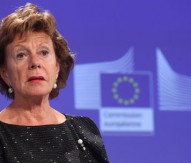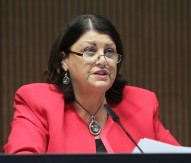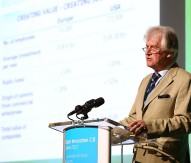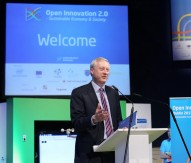
Looking to an innovative future
The citizen will be key to future innovation, that’s according to Professor Dr Martin Curley, director of Intel Labs Europe and chairman of the Open Innovation Strategy Policy Group. The EU’s next research and innovation framework programme, Horizon 2020, will make some steps towards to developing an open innovation ecosystem in Europe, vital to helping the continent compete on the international stage.
At the ‘Open Innovation 2.0’ conference, Curley spoke to Pan European Networks and began by outlining the role of the citizen and society in a quadruple helix innovation configuration.
The citizen is very important. Apple’s App Store is a key example of the reverse innovation pyramid. Instead of innovation being something done to the citizen, it’s something that they actually do themselves, which helps to create value. The App Store now has 900,000 apps and 50 billion downloads: it’s the users taking responsibility.
The citizen is at the centre of many businesses and Apple has identified this; it’s all about the user and their experience, and that’s the next frontier. The next frontier is where companies are designing for the collective experience and for sustainable intelligent living. You could have a design with the best user experience, but it may not be sustainable, e.g. buying large five/six litre cars might be a great user experience, yet it’s not sustainable. The next frontier will focus on the citizen and that’s what we are focusing on at this conference – collectively designing for sustainable, intelligent living with great experiences, but which are also environmentally and resource efficient.
We can identify patterns and we want to design generic, reasonable solutions to common recurring problems. There is a pattern emerging and if you systematically re-engineer using IT, you can have a better service and more access. Amazon has done this with books. I can now read a book wherever and whenever I want to and this is also more energy efficient. This is a pattern emerging that we could also apply to healthcare – we have to get over the inertia and develop ecosystems and realise that we want to change. Currently in healthcare, the financial models are totally unaligned with patient demands. If we could get them aligned, the financial incentives in treating people and keeping citizens healthy would be fantastic.
To what extent will Horizon 2020 help develop an open innovation ecosystem in Europe?
Whilst the final shape of Horizon 2020 is still being debated, it’s a model that we need in Europe, but we can learn from the US Innovation Strategy that Washington has already developed and published. President Barack Obama published a pyramid innovation strategy for the United States – at the bottom is investing in general infrastructure and skills, whilst at the top are a few specialist areas, for example healthcare and energy efficiency. The US Federal Government has also appointed Todd Park as the country’s chief technology officer (CTO), an entrepreneur who was very successful in driving transformation in healthcare.
Park understands the challenges of getting products to market, driving change, and has all the scars of an entrepreneur. Europe needs an innovation strategy and because the strategy is effectively formed by committee at present, innovation leadership in the form of a CTO and a chief innovation officer is required. We need someone who is passionate and credible, who could work with the President of the European Commission and set a new direction.
With a reduced budget, to what extent do you believe Horizon 2020 will still be able to achieve its R&I objectives?
There is a lot you can accomplish with €70bn, yet how you spend it spent is what matters. One of our key objectives at the conference is to define how we are going to spend the budget and ensure that the European taxpayer gets a return; one of our key recommendations is to take the output of this conference and help shape Horizon 2020. If we’re successful, the way Horizon 2020 is set up and funded will be different, delivering successful results over the coming years.
It’s also fantastic that there is the political will to invest in the Knowledge Economy, yet you cannot do this blindly. In his 2013 Royal Society speech, George Osborne, the UK finance minister, said: “Innovation is not a sausage machine. You don’t get it by a plan imposed by government and you cannot measure it just by counting patents or even just spend on R&D. It is all about creative interactions between science and business. You get innovation when great universities, leading-edge science, world-class companies and entrepreneurial start-ups come together.”
I’m optimistic about Horizon 2020 and the European Commission is very open to listening. FP7 was good, but we can do a lot better.
You’ve quoted several American examples: has Europe really got a long way to catch-up in terms of developing new products and services?
Yes it has, yet in Europe we have the propensity for co-creation. Intel is working with SAP in Belfast, Northern Ireland, on energy sustainability. We have been able to develop research that shows we could add a quarter of a million electric vehicles onto the roads of Ireland without any increase in supply capacity.
One of the initiatives we have announced is a collaboration between Intel, Glen Dimplex, ESB networks and Airtricity – this involves the full ecosystem of energy players in Ireland and we have announced plans to create the world’s first ‘Enernet’. Enernet is a concept of Bob Metcalfe (founder of 3Com and co-inventor of Ethernet) and it’s about IT, the internet and energy coming together. We’ve been trialling this concept with electric vehicles in parts of Dublin and we have a device called ‘energy live’, a middle-ware that provides a user interface to home owners but which also talks to aggregators and to TSO, creating a circular control system.
If Europe can become organised, carry out collaborative research, which can be accelerated by co-funding from Horizon 2020, we can certainly catch-up. We are behind, there is no question about it, but Intel has invested significantly in European R&D labs because we have seen that Europe can deliver results. I’m optimistic for Europe, but we certainly have some way to catch up.
Professor Dr Martin Curley




